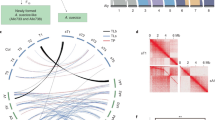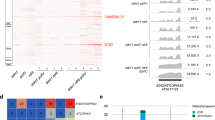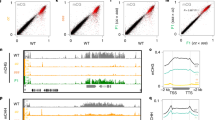Abstract
Despite evolutionary conserved mechanisms to silence transposable element activity, there are drastic differences in the abundance of transposable elements even among closely related plant species. We conducted a de novo assembly for the 375 Mb genome of the perennial model plant, Arabis alpina. Analysing this genome revealed long-lasting and recent transposable element activity predominately driven by Gypsy long terminal repeat retrotransposons, which extended the low-recombining pericentromeres and transformed large formerly euchromatic regions into repeat-rich pericentromeric regions. This reduced capacity for long terminal repeat retrotransposon silencing and removal in A. alpina co-occurs with unexpectedly low levels of DNA methylation. Most remarkably, the striking reduction of symmetrical CG and CHG methylation suggests weakened DNA methylation maintenance in A. alpina compared with Arabidopsis thaliana. Phylogenetic analyses indicate a highly dynamic evolution of some components of methylation maintenance machinery that might be related to the unique methylation in A. alpina.
This is a preview of subscription content, access via your institution
Access options
Subscribe to this journal
Receive 12 digital issues and online access to articles
$119.00 per year
only $9.92 per issue
Buy this article
- Purchase on Springer Link
- Instant access to full article PDF
Prices may be subject to local taxes which are calculated during checkout




Similar content being viewed by others
References
The Arabidopsis Genome Initiative. Analysis of the genome sequence of the flowering plant Arabidopsis thaliana. Nature 408, 796–815 (2000).
Hu, T. T. et al. The Arabidopsis lyrata genome sequence and the basis of rapid genome size change. Nature Genet. 43, 476–481 (2011).
Wang, X. et al. The genome of the mesopolyploid crop species Brassica rapa. Nature Genet 43, 1035–1039 (2011).
Dassanayake, M. et al. The genome of the extremophile crucifer Thellungiella parvula. Nature Genet. 43, 913–918 (2011).
Wu, H-J. et al. Insights into salt tolerance from the genome of Thellungiella salsuginea. Proc. Natl Acad. Sci. USA 109, 12219–12224 (2012).
Yang, R. et al. The reference genome of the halophytic plant Eutrema salsugineum. Front. Plant Sci. 4, 46 (2013).
Cheng, S. et al. The Tarenaya hassleriana genome provides insight into reproductive trait and genome evolution of crucifers. Plant Cell 25, 2813–2830 (2013).
Haudry, A. et al. An atlas of over 90,000 conserved noncoding sequences provides insight into crucifer regulatory regions. Nature Genet. 45, 891–898 (2013).
Slotte, T. et al. The Capsella rubella genome and the genomic consequences of rapid mating system evolution. Nature Genet. 45, 831–835 (2013).
Liu, S. et al. The Brassica oleracea genome reveals the asymmetrical evolution of polyploid genomes. Nature Commun. 5, 3930 (2014).
Tedder, A., Ansell, S. W., Lao, X., Vogel, J. C. & Mable, B. K. Sporophytic self-incompatibility genes and mating system variation in Arabis alpina. Ann. Bot. 108, 699–713 (2011).
Wingler, A., Stangberg, E. J., Saxena, T. & Mistry, R. Interactions between temperature and sugars in the regulation of leaf senescence in the perennial herb Arabis alpina L. J. Integr. Plant Biol. 54, 595–605 (2012).
Wang, R. et al. PEP1 regulates perennial flowering in Arabis alpina. Nature 459, 423–427 (2009).
Sanmiguel, P. & Bennetzen, J. L. Evidence that a recent increase in maize genome size was caused by the massive amplification of intergene retrotransposons. Ann. Bot. 82, 37–44 (1998).
Maumus, F. & Quesneville, H. Ancestral repeats have shaped epigenome and genome composition for millions of years in Arabidopsis thaliana. Nature Commun. 5, 4104 (2014).
Ma, J. & Bennetzen, J. L. Rapid recent growth and divergence of rice nuclear genomes. Proc. Natl Acad. Sci. USA 101, 12404–12410 (2004).
Zhang, X. et al. Genome-wide high-resolution mapping and functional analysis of DNA methylation in arabidopsis. Cell 126, 1189–1201 (2006).
Roudier, F. et al. Integrative epigenomic mapping defines four main chromatin states in Arabidopsis. EMBO J. 30, 1928–1938 (2011).
Hollister, J. D., Smith, L. M., Guo, Y-L., Ott, F., Weigel, D. & Gaut, B. S. Transposable elements and small RNAs contribute to gene expression divergence between Arabidopsis thaliana and Arabidopsis lyrata. Proc. Natl Acad. Sci. USA 108, 2322–2327 (2011).
Hall, A. E., Kettler, G. C. & Preuss, D. Dynamic evolution at pericentromeres. Genome Res. 16, 355–364 (2006).
Wijnker, E. et al. The genomic landscape of meiotic crossovers and gene conversions in Arabidopsis thaliana. eLife 2, e01426 (2013).
Kuittinen, H. et al. Comparing the linkage maps of the close relatives Arabidopsis lyrata and A. thaliana. Genetics 168, 1575–1584 (2004).
Zhang, X., Bernatavichute, Y. V., Cokus, S., Pellegrini, M. & Jacobsen, S. E. Genome-wide analysis of mono-, di- and trimethylation of histone H3 lysine 4 in Arabidopsis thaliana. Genome Biol. 10, R62 (2009).
Cokus, S. J. et al. Shotgun bisulphite sequencing of the Arabidopsis genome reveals DNA methylation patterning. Nature 452, 215–219 (2008).
Becker, C. et al. Spontaneous epigenetic variation in the Arabidopsis thaliana methylome. Nature 480, 245–249 (2011).
Law, J. A. & Jacobsen, S. E. Establishing, maintaining and modifying DNA methylation patterns in plants and animals. Nature Rev. Genet. 11, 204–220 (2010).
Zemach, A., McDaniel, I. E., Silva, P. & Zilberman, D. Genome-wide evolutionary analysis of eukaryotic DNA Methylation. Science 328, 916–919 (2010).
Matzke, M., Kanno, T., Daxinger, L., Huettel, B. & Matzke, A. J. M. RNA-mediated chromatin-based silencing in plants. Curr. Opin. Cell Biol. 21, 367–376 (2009).
Tsukahara, S., Kobayashi, A., Kawabe, A., Mathieu, O., Miura, A. & Kakutani, T. Bursts of retrotransposition reproduced in Arabidopsis. Nature 461, 423–426 (2009).
Mirouze, M. et al. Selective epigenetic control of retrotransposition in Arabidopsis. Nature 461, 427–430 (2009).
Acknowledgements
We thank José Jiménez-Gómez for helpful discussion throughout the entire project and Marcus Koch, Maarten Koornneef as well as Miltos Tsiantis for critical reading of the manuscript. We apologize to all colleagues whose work has not been cited here because of space constraints. The TRANSNET consortium was initiated based on the funding of PLANT KBBE ‘Transcriptional networks and their evolution in the Brassicaceae (TRANSNET)’. B.S. was supported by a postdoctoral fellowship from the TRANSNET consortium. C.C. was supported by a postdoctoral fellowship first from Investissements d'Avenir ANR-10-LABX-54 MEMO LIFE and then from the European Union EpiGeneSys FP7 Network of Excellence (number 257082). R.C.M.T. was supported by Investissements d'Avenir ANR-10-LABX-54 MEMO LIFE. J.L.M was supported by an Alexander von Humboldt Postdoctoral Fellowship. C.B.S was supported by a postdoctoral fellowship from the TRANSNET consortium. R.I.F. was supported by a post-doctoral Juan de la Cierva contract (JCI-2010-07909) from Ministerio de Ciencia e Innovación (MICINN). A.P. was supported by the research grant PE-1853/2 from German Research Foundation. Work in the Carbonero's group was supported by the Spanish grants BFU2009-11809 and Consolider CSD2007-00057 from Ministerio de Ciencia e Innovación (MICINN). C.A-B. laboratory was funded by grant BIO2013-45407-P from the Ministerio de Economía y Competitividad of Spain. Work in the Colot group was supported by the Agence Nationale de la Recherche (Investissements d'Avenir ANR-10-LABX-54 MEMO LIFE and ANR-11-IDEX-0001-02 PSL* Research University) and the European Union (EpiGeneSys FP7 Network of Excellence number 257082). Work in the Weigel group was supported by an FP7 project AENEAS and the TRANSNET consortium. Work in the Quesneville group was supported by the TRANSNET consortium and by the French national research agency (ANR-08-KBBE-012). Work in the Lysak group was supported by a research grant from the Czech Science Foundation (P501/12/G090) and by the European Social Fund (projects CZ.1.07/2.3.00/30.0037 and CZ.1.07/2.3.00/20.0189). Work on A. alpina in the Coupland laboratory is partly funded by the Cluster of Excellence on Plant Sciences (CEPLAS). Work in the Paz-Ares laboratory has been supported by the French-German-Spanish Trilateral program on Plant Genomics (grant TRANSNET) and Spanish Ministry of Economy competiveness (CONSOLIDER 2007-28317, BIO2011-30546). Schneeberger, Coupland, Weigel and Pecinka groups were supported by the Max Planck Society.
Author information
Authors and Affiliations
Contributions
E.M.W., S.C.S., C.A-B., F.R., P.C., J.P.A., S.J.D., A.P., H.Q., V.C., M.A.L., D.W., G.C. and K.S. conceived this study and supervised experiments and analyses. L.C., M.C.A., B.S., S.B., L.C., J.L.M., M.C.B., N.B., T.P., L.D.L., I.M. and C.B.S. prepared samples for DNA and RNA sequencing. B.S. prepared samples and performed ChIP and MeDIP experiments. C.B. prepared samples and performed bisulphite experiments. N.W., M.C.A. and C.A-B. constructed genetic maps. T.M. and M.A.L. conducted FISH, chromosome painting and karyotype evolution analysis. K.J.V.N., E.M.W. and N.W. conducted de novo assembly of A. alpina. C.K. conducted de novo assembly of A. montbretiana. G.V.J., E.M.W., C.B.S. and M.Z. performed genome annotations of A. alpina together with all participants of the annotation jamboree held in 2012 in Paris, France. E.M.W. performed genome annotations of A. montbretiana. E.M.W., V.R. and C.C. conducted expression analyses. F.M. performed transposon annotations. E.M.W., F.M., M.P. and K.S. performed transposon analysis. E.M.W., C.C., R.C.M.T. and K.S. performed analysis of ChIP-seq and MeDIP-seq data. E.M.W., C.B., J.H. and K.S. performed BS-seq analysis. E.M.W., V.R. and K.S. conducted comparative genomic analyses. E.M.W. and K.S. wrote the paper with contributions from all authors.
Corresponding authors
Ethics declarations
Competing interests
The authors declare that no competing interests exist.
Supplementary information
Rights and permissions
About this article
Cite this article
Willing, EM., Rawat, V., Mandáková, T. et al. Genome expansion of Arabis alpina linked with retrotransposition and reduced symmetric DNA methylation. Nature Plants 1, 14023 (2015). https://doi.org/10.1038/nplants.2014.23
Received:
Accepted:
Published:
DOI: https://doi.org/10.1038/nplants.2014.23
This article is cited by
-
Chromosome-scale and haplotype-resolved genome assembly of a tetraploid potato cultivar
Nature Genetics (2022)
-
Comparative cytogenomics reveals genome reshuffling and centromere repositioning in the legume tribe Phaseoleae
Chromosome Research (2022)
-
Differential responses of the scavenging systems for reactive oxygen species (ROS) and reactive carbonyl species (RCS) to UV-B irradiation in Arabidopsis thaliana and its high altitude perennial relative Arabis alpina
Photochemical & Photobiological Sciences (2021)
-
A network of transcriptional repressors modulates auxin responses
Nature (2021)
-
Meiotic analyses show adaptations to maintenance of fertility in X1Y1X2Y2X3Y3X4Y4X5Y5 system of amazon frog Leptodactylus pentadactylus (Laurenti, 1768)
Scientific Reports (2020)



